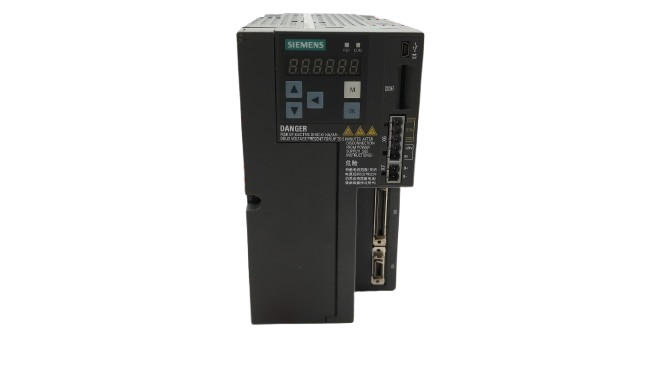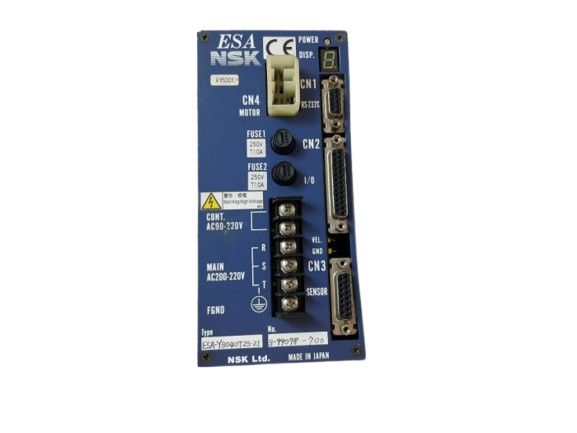Industrial automation in a dynamic environment is characterized by efficiency, precision, and reliability. Among the most important technologies driving improvements in these areas is the servo drive. Advanced systems are necessary for controlling motor movement to achieve high performance in automation processes. Servo drives increase the speed, accuracy, and energy efficiency of machinery and systems, making them important in modern industrial settings.
In this blog, we’ll explore how servo drives contribute to boosting efficiency in industrial automation, their key benefits, how they work, and the industries that rely on them. Let’s dive into the world of servo drives and their impact on automation systems.
What are Servo Drives?

A servo drive is a part of any application's servo system to operate electrical motors precisely under high-accuracy specifications for speed and torque. Essentially designed to go well with the capabilities of the servo motor to run variable load operations and operate variable speeds, these drives take feed from a motor and work within real-time improvements as governed through a controlling operation. Servo drives are an essential way to obtain the desired motion characteristics like smoothness, accuracy, and speed within different machines and processes of industrial automation. Fast and efficient servo drives help any business meet a higher demand in production and minimize operating costs.
Working Of Servo Drive
In order to understand how servo drive can improve efficiency, it is basic to understand their working mechanism. The key elements of a servo drive system are as under:
Servo Motor: This is the motor that takes instruction from the drive. Electrical signals of the drive control the performance of the motor in terms of speed, position, and torque.
Controller: A controller sends the necessary commands to the servo drive. It usually uses feedback systems to monitor the motor's performance and adjusts the output of the drive to achieve the desired motion.
Common feedback devices are encoders and resolvers, which provide real-time data of the motor's position, speed, and torque.
In the servo drive system, an electrical power supply into the motor would be controlled and determined by inputs from the control and feedback system. Such ongoing adjustment ensures smooth operation at maximum parameters for smoother, more efficient operation.
Benefits of Servo Drive Application to Industrial Automation
1. Control Accuracy
High-precision motion control is one of the major advantages of servo drives. In industrial applications, material handling, packaging, and CNC machining require precise movements. Servo drives allow precision control over speed, torque, and position so that machines can perform complex tasks with minimal deviation. Such accuracy is needed to produce quality and accurate manufactured products, avoid errors, and waste.
2. Energy Efficiency
Energy saving is also one of the major concerns of increased energy prices related to current processes of manufacturing. Servo motors save much of the energy utilized as it reduces the amount drawn by the motors based on various load conditions demanded. Traditional motor speeds are same even though any load is applied or not whereas servo motors differ their speed of operation with relation to the conditions during real-time hours and, consequently, the wattage of that motor decreases according to low conditions.
3. Increased Efficiency
Servo drives give faster production cycles because of their high speed performance with accuracy. Servo drives on the machines enable better positioning, picking, and assembly at higher speeds, thereby achieving better throughput. The business entities can achieve more in less time by increasing their production, and businesses can meet higher production demands due to improved speed and less down time. Servo drives also provide immediate adjustment to various operation parameters; hence, it allows manufacturers to change them according to different requirements. Servo drives prevent long or complete down times so that producers do not have to suffer in scheduling and eventually production.
4. Low Wears
Unlike the usual motors that operate in on-off cycles, thereby experiencing mechanical wear, servo drives operate smoothly and gradually, thereby minimizing the effect of strain put on the motor. Gentle acceleration and deceleration reduce the mechanical stress caused on components leading to longer life and lower cost of maintenance. Servo drives also have high overload protection, preventing motor damage from abrupt changes in load. This assures the full system with maximized lifespan, less repaired and replaced items, and a lot of flexibility.
5. Compact and Flexible Design
Servo drives are generally more compact than a traditional motor control system, so they are the best choice for systems that have space constraints. Though their size is relatively smaller, it does not affect their performance, and they can simply be bolted onto existing automation systems. The compact system also provides flexibility in system arrangements to ensure optimal use of space and layout without compromising functionality.
Applications of Servo Drives in Industrial Automation
From automated assembly lines at car manufacturing, food packaging facilities, to every other industrial undertaking, servo drives are used abundantly. Just below are major industries and areas where servo drivers are applied directly:

1. Robotics
Servo drives are the most critical component in almost all robots. Robots deploy intense precision during movement to complete tasks such as welding, assembling, and placing. Servo drives control robot arm motors, ensuring accurate movement with minimal variance. Such machines are widely utilized in industries involving automotive, electronics, and pharmaceutical where high precision is needed.
2. CNC Machining
Servo drives are of the essence in CNC machines as it enhances the capability to make sharp and precise cutting, drilling, or milling actions of the tool that can only be done through control system feedback with multiple directionality of motion. It also adjusts the tool based on its movements. Precisely accurate movements can enhance the parts in exactness required, ensuring perfect quality with least waste products.
3. Conveyor System
Servo drives are also applied in material handling and conveyor systems for control of product flow in the production line. This kind of system demands precise speed and position control for the efficient flow of products without downtime. Servo drives allow for stable performance, so there is an easy and efficient way of sorting, packaging, and transportation of the product.
4. Packaging Machines
Packaging machines require servo drives to be used in high-speed applications with accuracy for operations like sealing, labeling, and filling. The servo drive allows the packaging process to be both fast and accurate, which in turn yields higher output with fewer errors. In addition, servo drives facilitate easy adjustments in packaging parameters and are suitable for handling different product sizes and types.
5. Textile Manufacturing
In textile manufacturing, servo drives are used in knitting machines, weaving machines and fabric cutting machines, requiring precise speed and position control to produce high-quality fabrics. Working in a consistent manner, it avoids excessive waste, further improving the quality of fabrics produced.
6. Food and Beverage Processing
Servo drives are applied in the food and beverage industry in filling, sorting, and packaging applications. It increases the production efficiency through fast and accurate processes that ensure that food products are produced and packaged to meet high quality standards.
Choosing the Correct Servo Drive for Your System
The following are some of the factors to consider when choosing a servo drive for industrial automation:
- Type of motor: Servo drive to match the motor type in your application, perhaps either a brushless or brushed DC motor, an AC motor.
- Load Requirement: Determination of amount of torque, speed desired at your end is required; one will find servo drives through the determination based on motor-load capability with regards to desirable performance in the aspects of speed.
- Control Method: Many servo drives have different control methods. These include position control, speed control, and torque control. Ensure the drive matches your application's control method.
- Power Rating: The servo drive power output should be adequate to power your system. Just consult its voltage and current ratings.
- Integration and Compatibility: Ensure that the servo drive integrates seamlessly with your existing automation system, including controllers and feedback devices.
- Cost and Support: While servo drives offer significant benefits, it’s essential to balance performance with cost. Choose a drive that fits within your budget while meeting your technical requirements. Additionally, ensure that reliable technical support and warranties are available.
Servo drives have revolutionized industrial automation with increased efficiency, precision, and energy saving in the operations of industries. Servo drives apply to robotics, CNC machining, packaging, material handling, as well as several other applications for the achievement of more from the growing demands while delivering on the same level of optimum performance. Servo drives offer accuracy with enhanced energy efficiency and low wear factor. For businesses, this remains a way of improving productivity with reduced operation cost and competition in staying up with a rapid rise of the technology involved in the landscape. Servo drive technology is no longer an option but necessity for industries which look to optimize their operations and ensure long-term success. Whether you are upgrading existing machinery or designing new automation systems, servo drives will definitely enhance your efficiency, reliability, and output.





Validate your login
Sign In
Create New Account